Ultra Low Noise Poroelastic Road Surfaces
Abstract
:1. Introduction
2. Materials and Methods
2.1. Test Pavements
- By mixing the ingredients on the spot and spreading the wet mix manually or with an asphalt finisher. This is called the in situ application.
- The mix is made in the factory and put in moulds, given the time to cure resulting in slabs of 0, 5 m × 1 m. These slabs are then glued to the sublayer on the test area.
- Smaller slabs are produced like in point 2 above and are glued on cement concrete blocks in the factory, which are then laid on the test area in the classical way.
2.2. Test Tires
2.3. Tire/Road Noise Measuring Methods
2.4. Rolling Resistance Measuring Methods
3. Results
3.1. Tire/Road Noise Reduction by PERS
3.1.1. Laboratory Measurements of Tire/Road Noise on PERS
3.1.2. Road Measurements of Tire/Road Noise on PERS
3.2. Tire Rolling Resistance on PERS
3.2.1. Laboratory Measurements of Rolling Resistance on PERS
3.2.2. Road Measurements of Rolling Resistance on PERS
3.3. Fire Risk on PERS
3.3.1. Emission of Toxic Fumes During PERS Fire
3.3.2. Fire Spread During Car Fire on PERS Pavement
4. Conclusions
Acknowledgments
Author Contributions
Conflicts of Interest
Abbreviations
| CPX | Close Proximity Method of tire/road noise measurements |
| (CN)2 | Dicyanide |
| CRR | Coefficient of rolling resistance |
| DAC | Dense Asphalt Concrete |
| EV | Electric Vehicle |
| HCN | Hydrogen Cyanide |
| MPD | Mean Profile Depth |
| M+S | Mud and Snow tire |
| PERS | Poroelastic Road Surface |
| SMA | Stone Matric Asphalt |
| SPL | Sound Pressure Level |
| TUG | Technical University of Gdansk |
References
- Ejsmont, J.; Goubert, L.; Swieczko-Zurek, B.; Ronowski, G. Poroelastic low noise road surfaces. In Proceedings of the Rubberized Asphalt-Asphalt Rubber RAR 2015 Conference, Las Vegas, NV, USA, 4–7 October 2015; pp. 699–710.
- Sandberg, U.; Ejsmont, J.A. Tire/Road Noise Reference Book; Informex: Kisa, Sweden, 2002. [Google Scholar]
- Ohnishi, H.; Meiarashi, S.; Nanri, Y.; Takagi, K. Vehicle Noise Reduction Effect of Poro-Elastic Road Surface. J. Ince Jpn. 2000, 24, 68–76. [Google Scholar]
- Sandberg, U.; Goubert, L. Poroelastic Road Surface (PERS): History of R&D Work and Noise-Reducing Mechanisms. In Proceedings of the Internoise 2011, Osaka, Japan, 4–7 September 2011.
- Goubert, L. Construction of the PERSUADE test tracks, deliverable D4.10 of the PERSUADE project. document PERSUADE-BRRC-D410-V01-WP4–151202-Construction of test tracks. Avaliable online: http://www.persuadeproject.eu (accessed on 6 April 2016).
- ISO/TS 11819–3 Acoustics-Measurement of the Influence of Road Surfaces on Traffic Noise-Part 3: Reference Tires; International Organization for Standardization: Genève, Switzerland, 1997.
- ISO/DIS 11819–2 Acoustics-Method for Measuring the Influence of Road Surfaces on Traffic Noise-Part 2: Close-Proximity Method; International Organization for Standardization: Genève, Switzerland, 2012.
- Swieczko-Zurek, B.; Jaskula, P.; Ejsmont, J.; Kędzierska, A.; Czajkowski, P. Rolling Resistance and Tire/Road Noise on Rubberized Asphalt Pavement in Poland. In Proceedings of the Rubber Asphalt-Asphalt Rubber RAR 2015 Conference, Las Vegas, NV, USA, 4–7 October 2015.
- Ejsmont, J.; Ronowski, G.; Taryma, S.; Mioduszewski, P.; Sobieszczyk, S.; Swieczko-Zurek, B. Relations between Tire/Road Noise and Tire Rolling Resistance on Different Road Pavements. In Proceedings of the Internoise 2012, New York, NY, USA, 19–22 August 2012.
- Ejsmont, J.; Swieczko-Zurek, B. Methods of Tire Rolling resistance Measurements. In Proceedings of the Troisième Congrès Tunisien de Mécanique COTUME’ 2014, Sousse, Tunisia, 24–26 March 2014.
- ISO 18164-2005 Passenger Car, Truck, Bus and Motorcycle Tires-Methods of Measuring Rolling Resistance; International Organisation for Standardization: Genève, Switzerland, 2005.
- ISO 28580-2009 Passenger Car, Truck and Bus Tires-Methods of Measuring Rolling Resistance-Single Point Test and Correlation of Measurement Results; International Organisation for Standardization: Genève, Switzerland, 2009.
- Świeczko-Żurek, B.; Ejsmont, J.; Motrycz, G.; Stryjek, P. Risks related to car fire on innovative Poroelastic Road Surfaces-PERS. Fire Mater. 2015, 39, 95–108. [Google Scholar] [CrossRef]
- Meiarashi, S. Porous Elastic Road Surface as an Ultimate Highway Noise Measure. In Proceedings of the XXIInd PIARC World Road Congress, Durban, South Afria, 19–25 October 2003.
- Sumi, K.; Tsuchiya, Y. Toxic Gases and Vapours Produced at Fires. Can. Build. Dig. 1971, 144, 4–8. [Google Scholar]
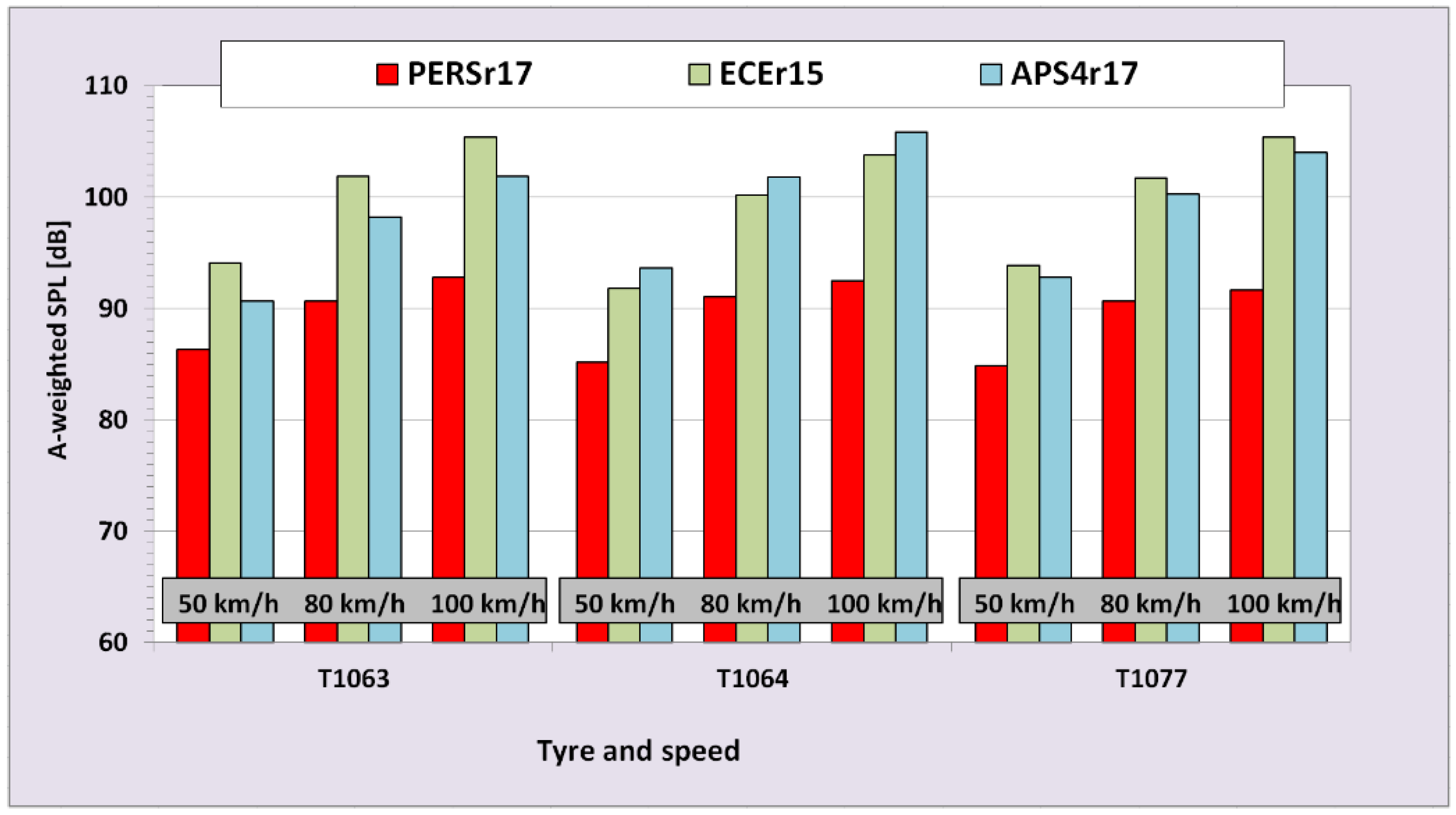
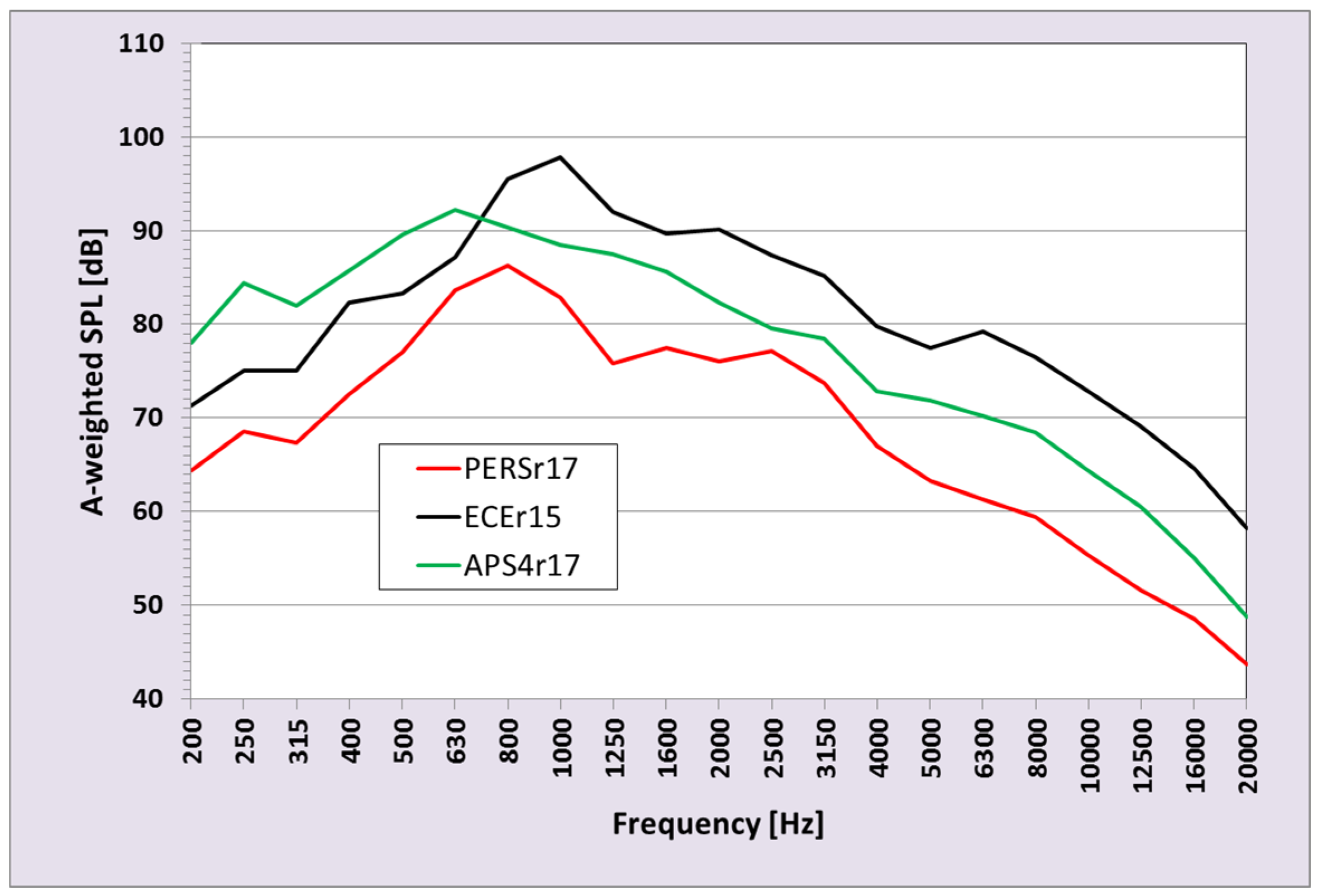
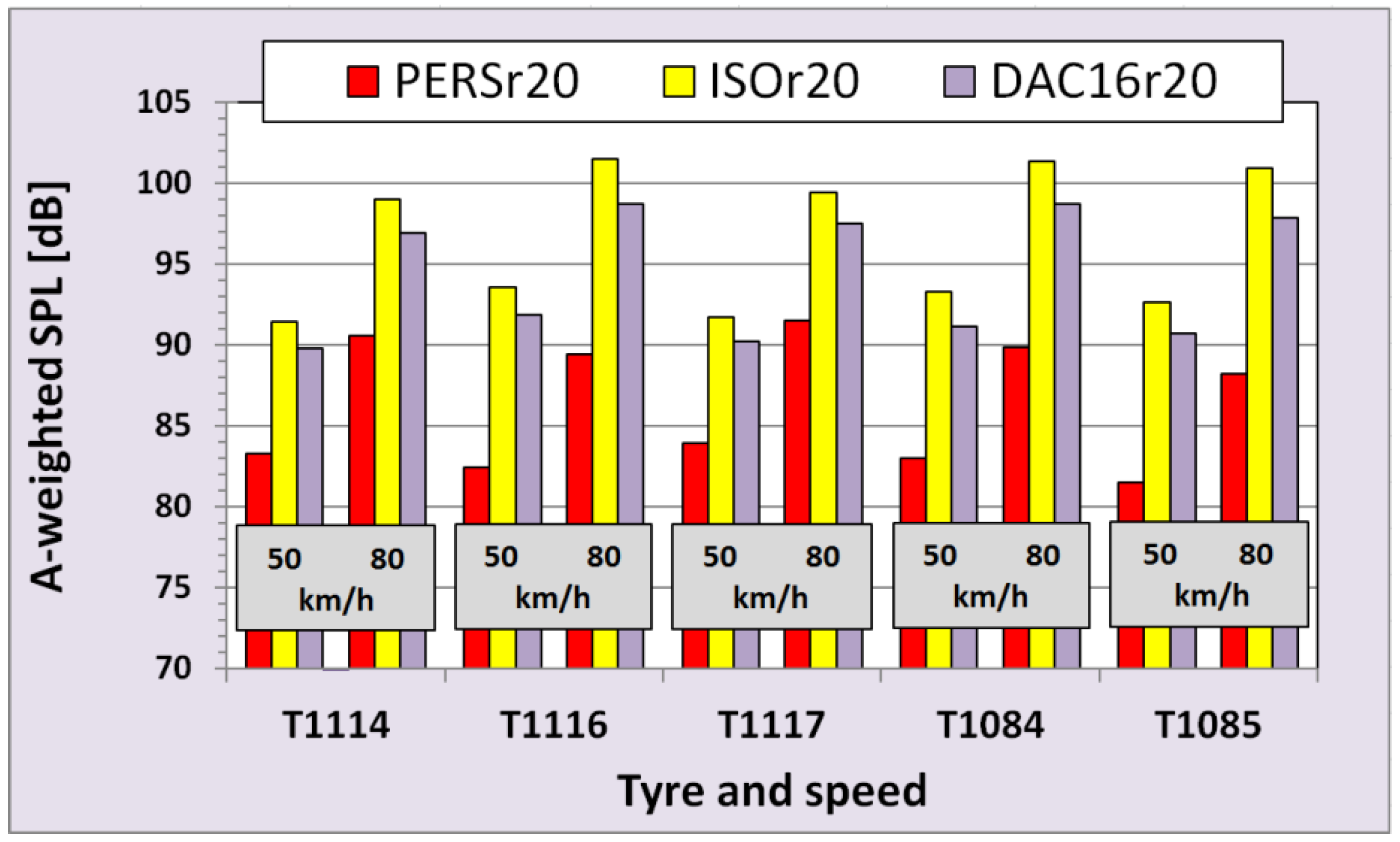
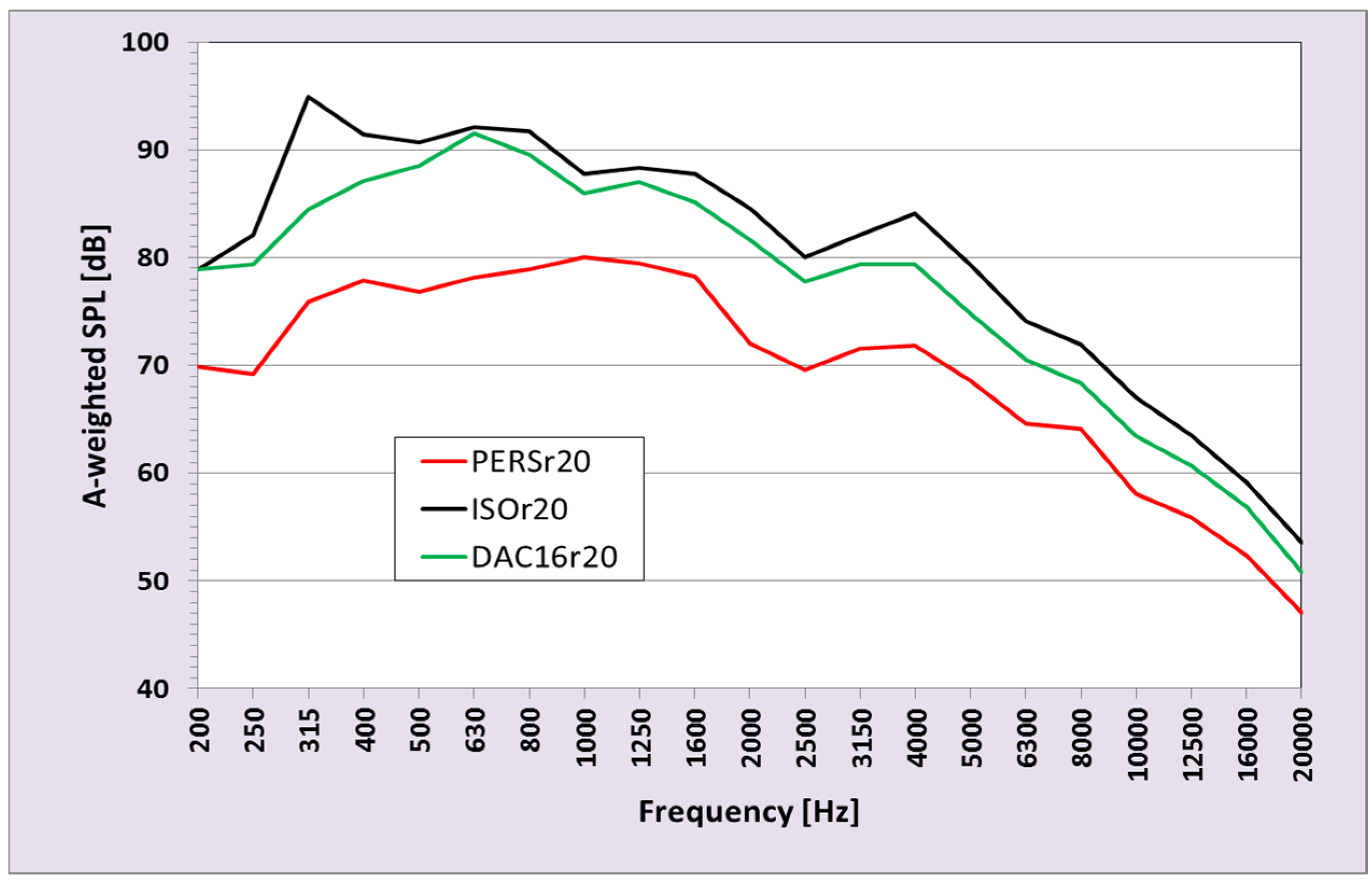
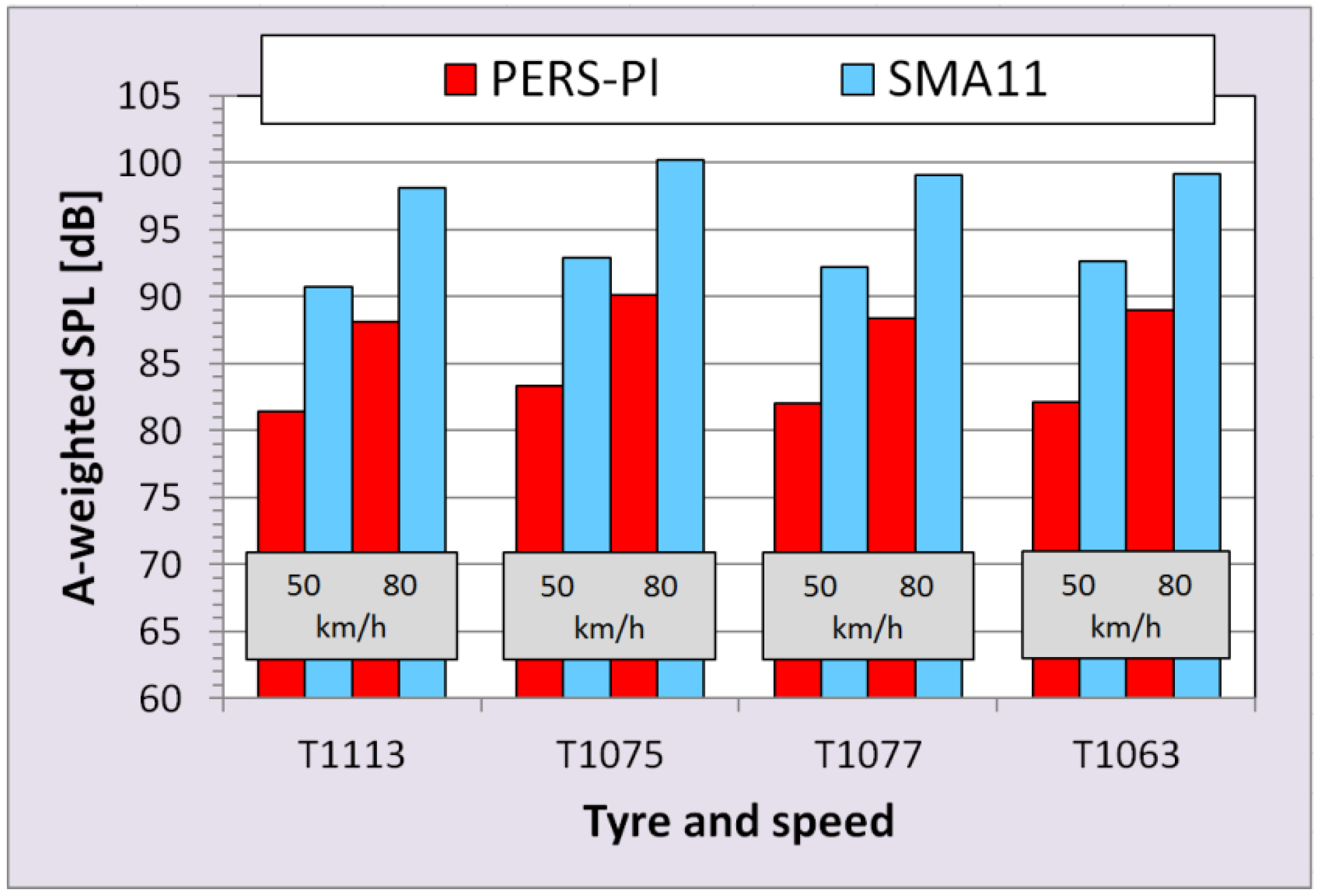
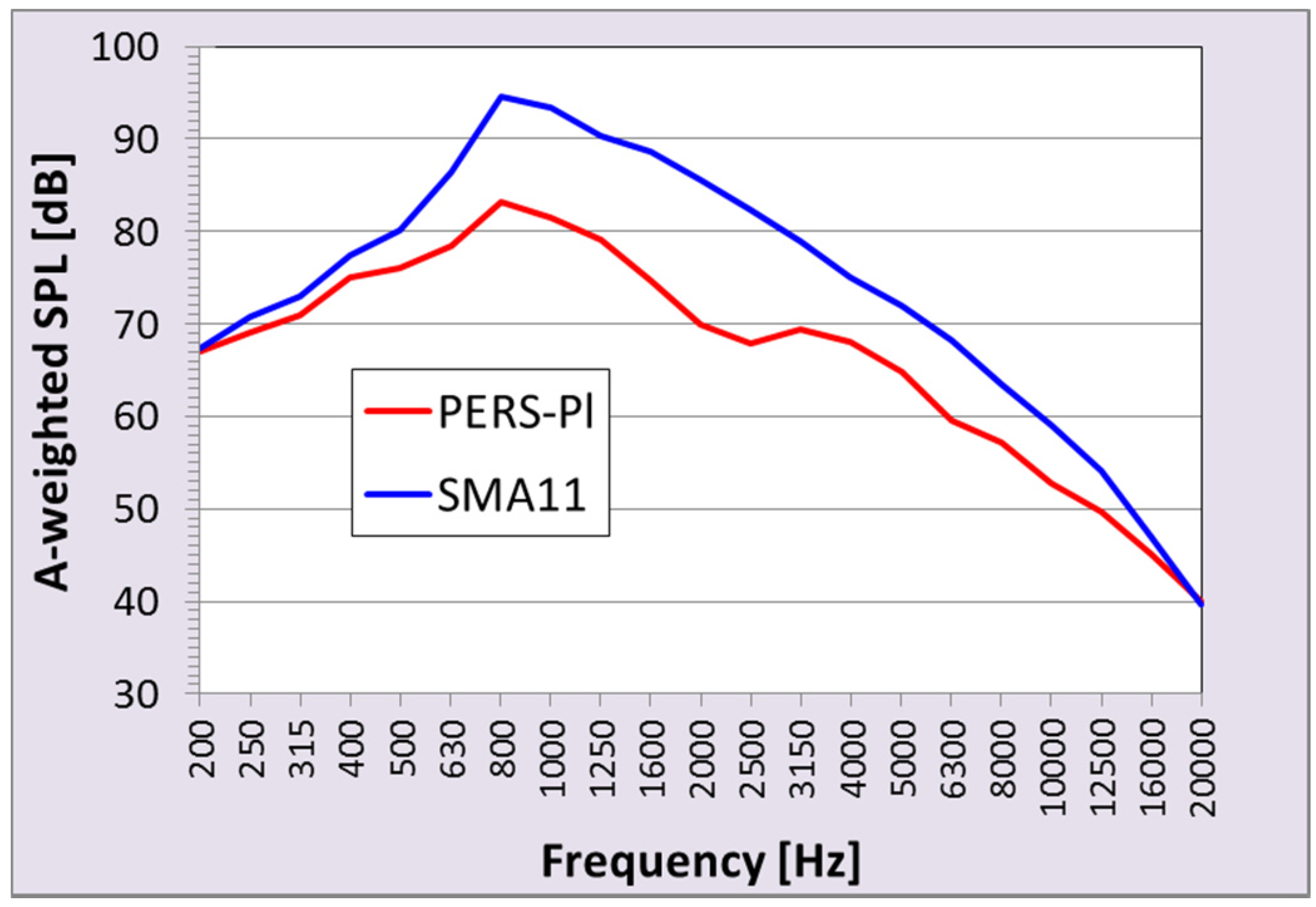
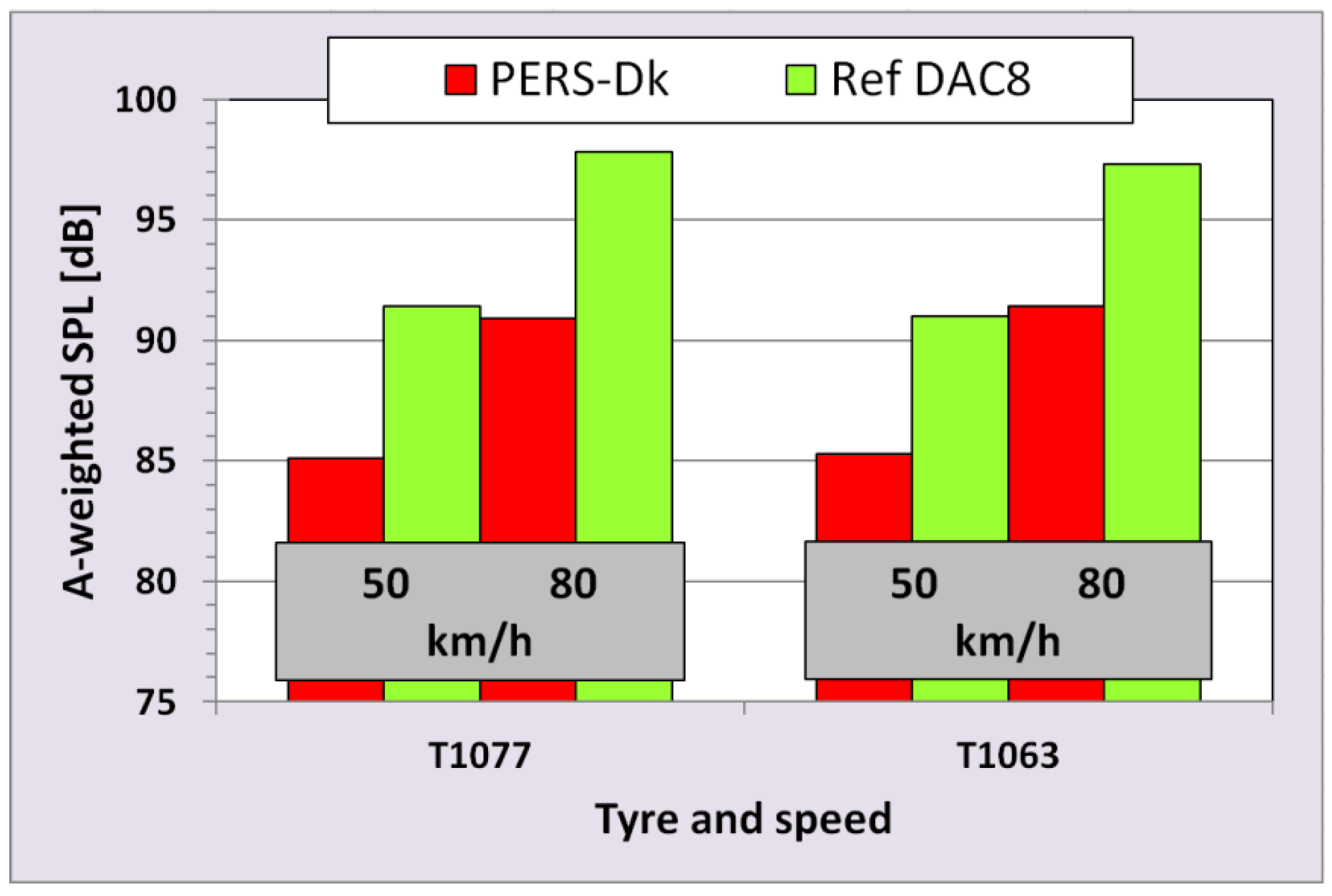
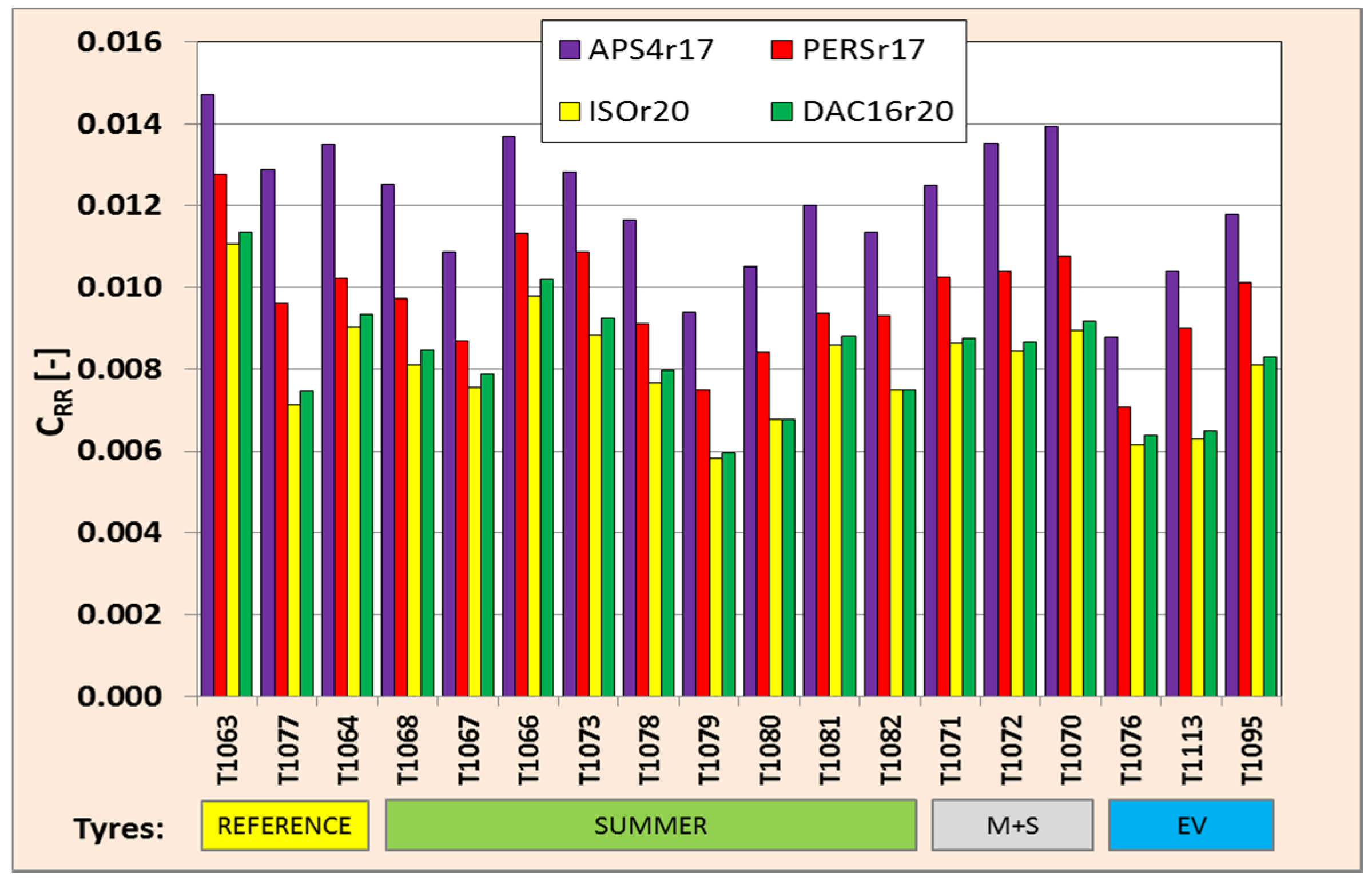
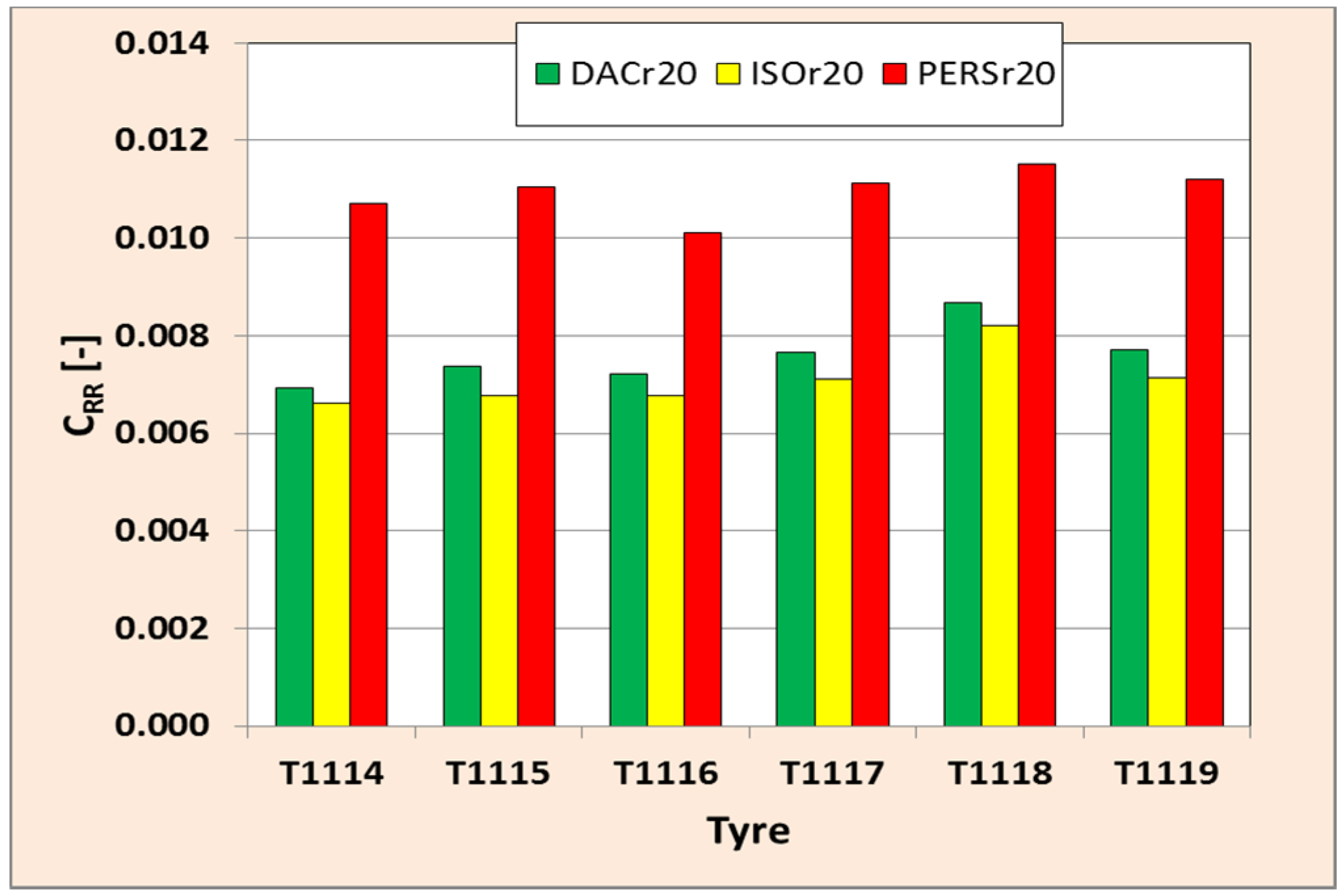

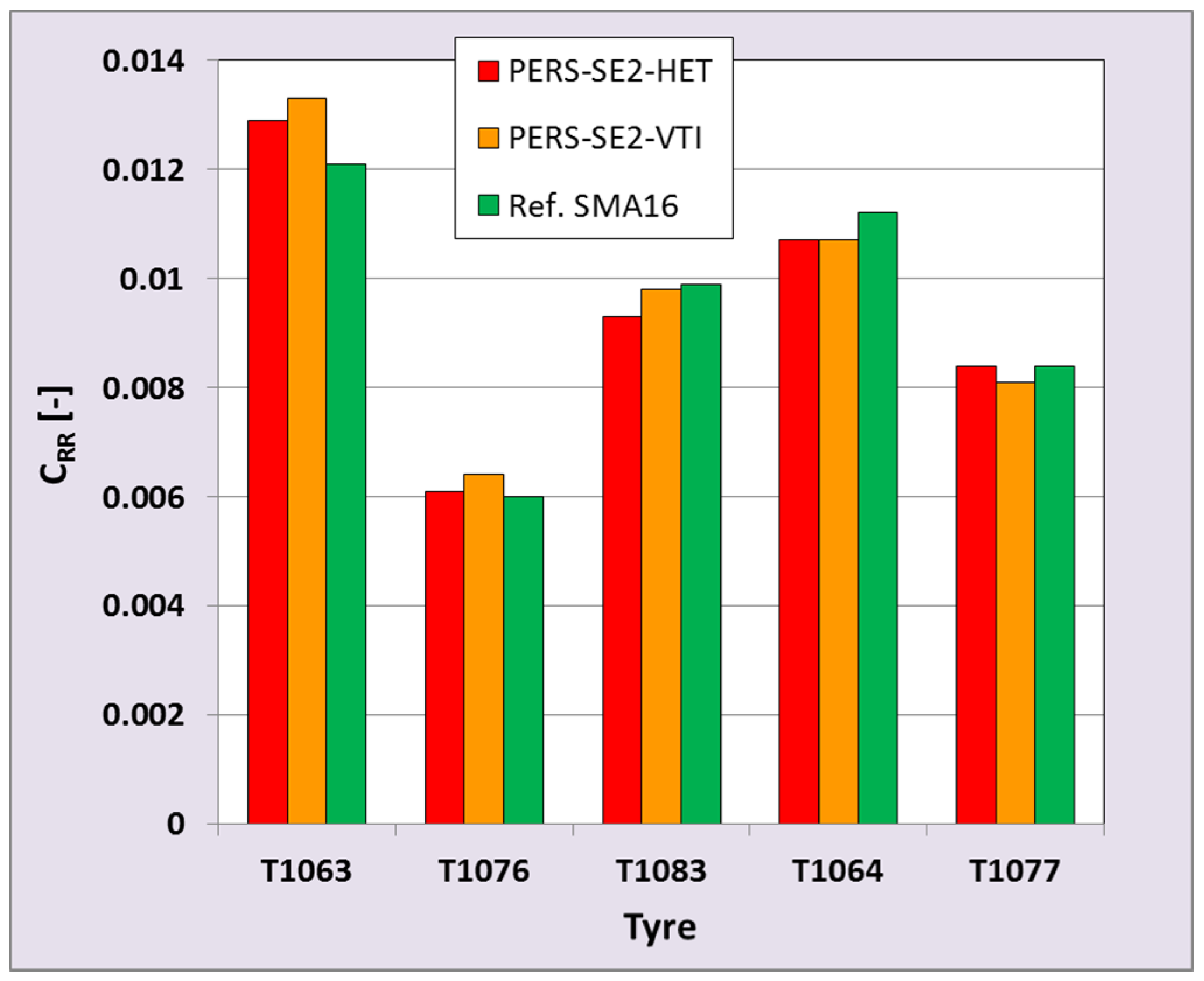
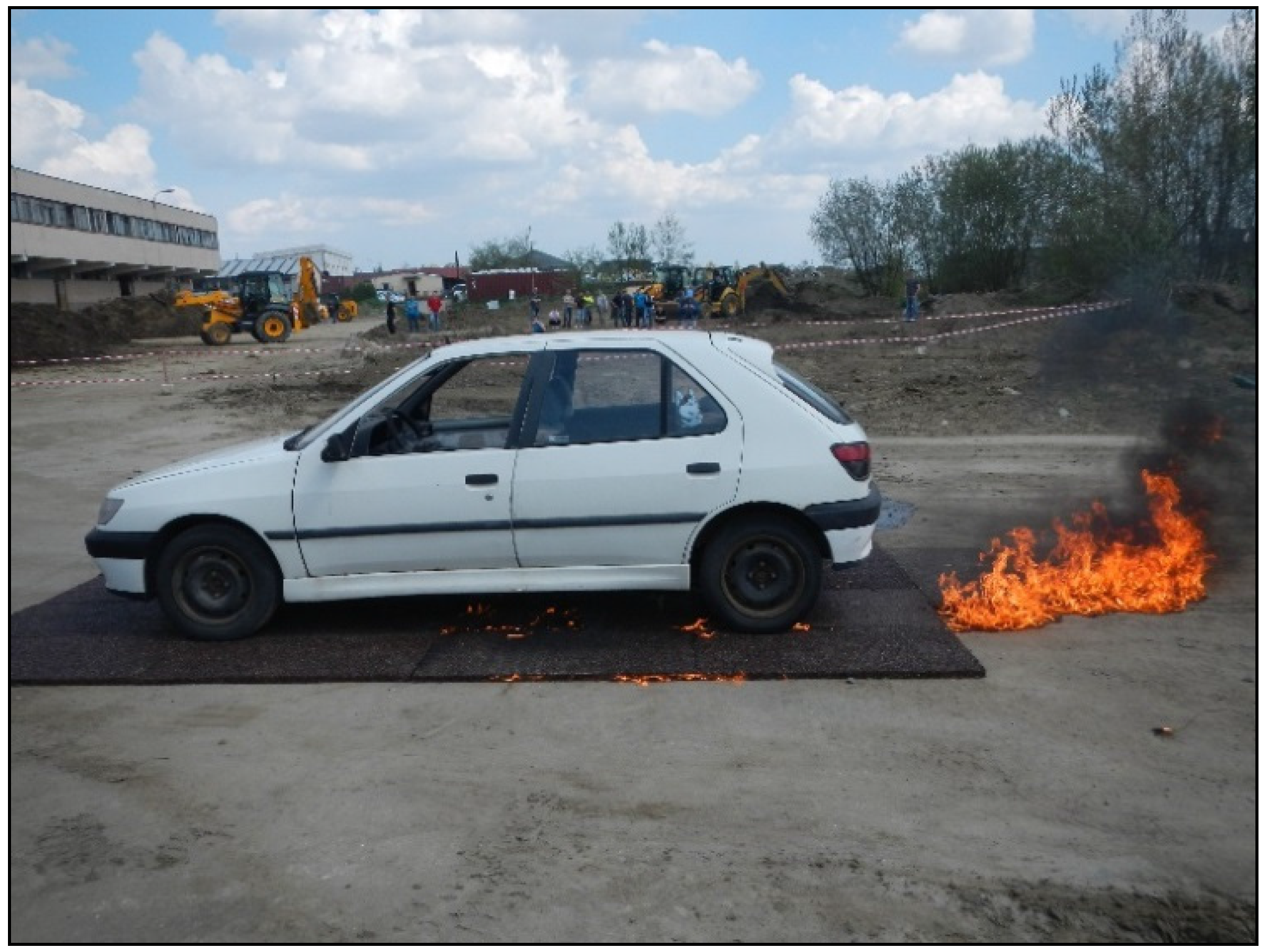
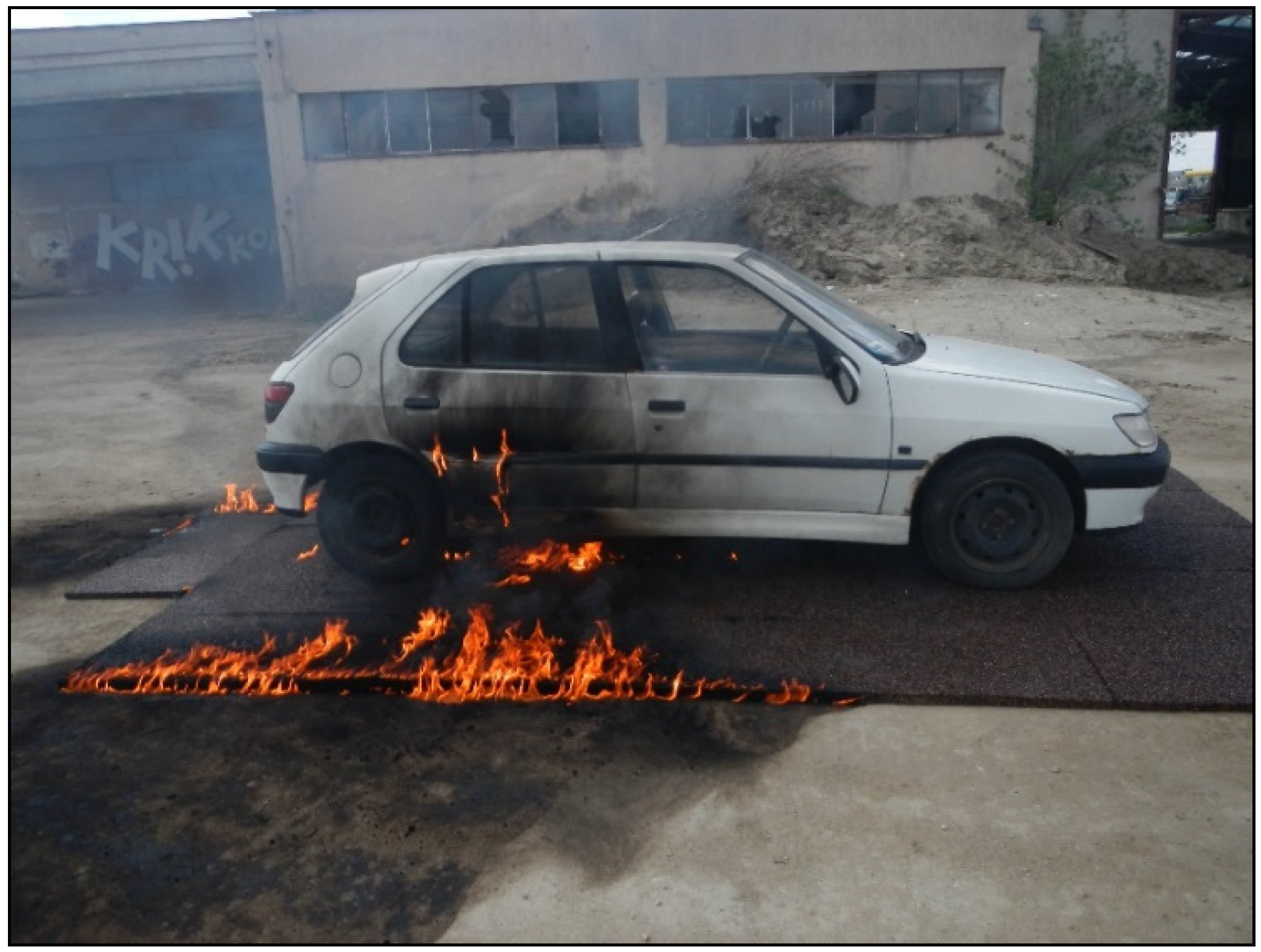
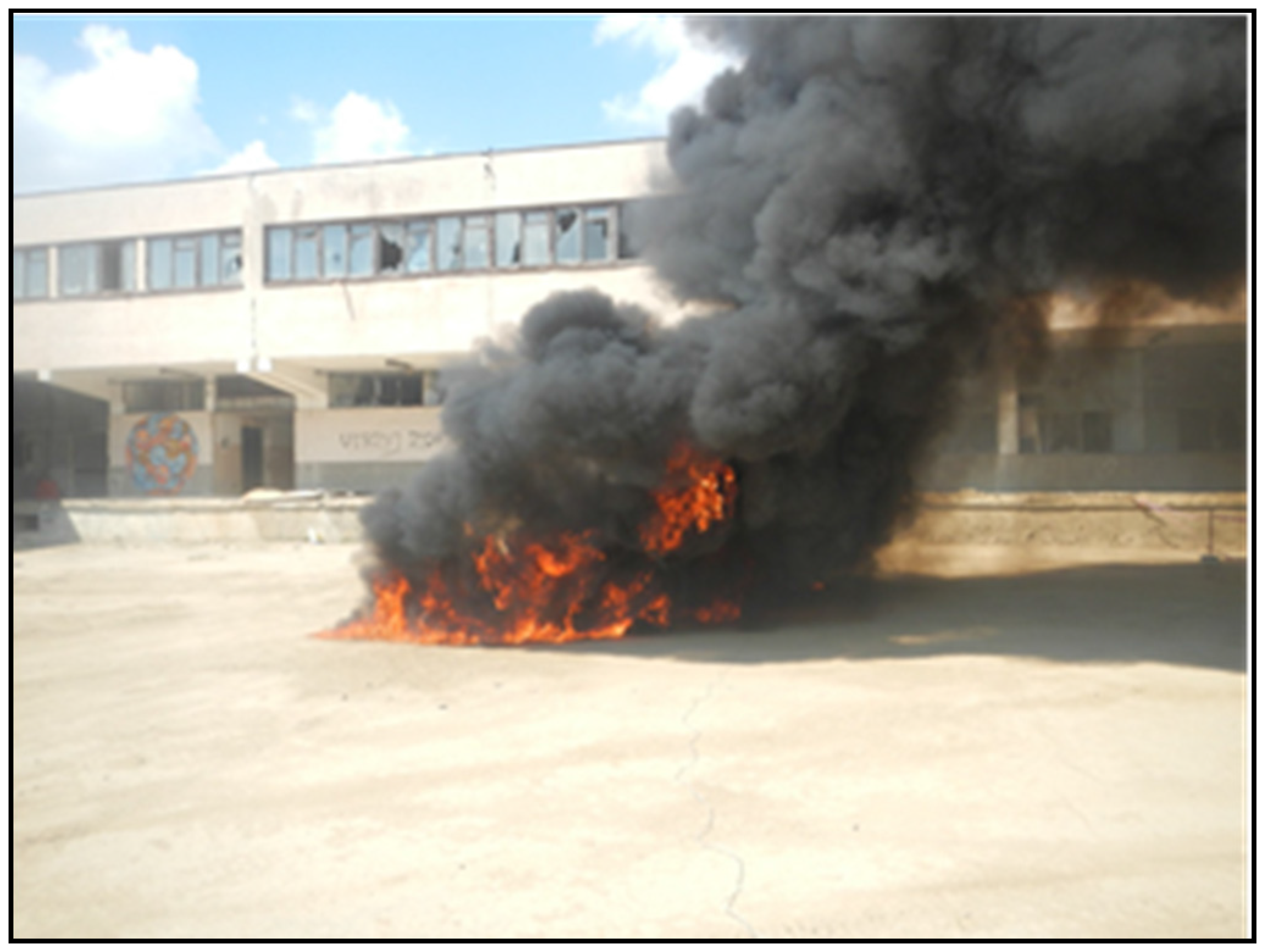
| Code | Country | Mix | Application Method |
|---|---|---|---|
| PERS-B | Belgium | #1 | In situ, classic asphalt finisher |
| PERS-DK | Denmark | #1 | In situ, gussasphalt finisher |
| PERS-SE2-HET2 | Sweden | #2 | 1 m × 1 m slabs, HET company produced |
| PERS-SE2-HET3 | Sweden | #2 | 1 m × 1 m slabs, HET produced |
| PERS-SE2-VTI | Sweden | #2 | In situ, manual application |
| PERS-Sl | Slovenia | #2 | Small slabs, HET produced, on concrete blocks |
| PERS-Pl | Poland | #1 | In situ, classic asphalt finisher |
| Code | Manufacturer and Model | Size | Remarks |
|---|---|---|---|
| T1063 | Avon AV4 | 195R14C | Reference tire according to ISO/CD 11819-3 [6] |
| T1077 | Uniroyal TIGER PAW | P225/60R16 | Reference tire according to ISO/CD 11819-3 |
| T1064/68 | Michelin PRIMACY HP | 225/60R16 | Informal reference tire at TUG |
| T1075/76 | Continental BLUECO | 195/50R18 | Tire designed for electric vehicles |
| T1113 | Bridgestone ECOPIA EP500 | 155/70R19 | Tire designed for electric vehicles |
| T1066 | Wanli S-1200 | 196/60R15 | Summer tire |
| T1067 | Continental ECOCONTACT 5 | 195/60R15 | Summer tire |
| T1073 | Avon ZV5 | 195/65R15 | Summer tire |
| T1078 | Goodyear EFFICIENT GRIP | 195/65R15 | Summer tire |
| T1079 | Bridgestone ECOPIA EP001S | 195/65R15 | Summer tire |
| T1080 | Michelin ENERGY SAVER X GREEN | 215/55R17 | Summer tire |
| T1081 | Dunlop SPORT BLURESPONSE | 195/65R15 | Summer tire |
| T1082 | Michelin ENERGY SAVER X GREEN | 195/55R15 | Summer tire |
| T1071 | Vredestein QUATRAC 3 | 195/50R15 | Winter tire |
| T1072 | Yokohama WDRIVE | 195/50R15 | Winter tire |
| T1070 | Vredestein WINTRAC EXTREME | 205/55R16 | Winter tire |
| T1114 | Sava CIT U3 | 275/70R22.5 | Truck tire, retreaded |
| T1115 | Giti GT867 | 275/70R22.5 | Truck tire, retreaded |
| T1116 | Dunlop SP372 CITY | 275/70R22.5 | Truck tire |
| T1117 | Michelin M758 | 275/70R22.5 | Truck tire, retreaded |
| T1118 | Bridgestone M758 | 275/70R22.5 | Truck tire, retreaded |
| T1119 | Dunlop SP372 CITY | 275/70R22.5 | Truck tire, retreaded |
| Code | Description | Placement | Mean Profile Depth (MPD) [mm] |
|---|---|---|---|
| ECEr15 | Replica of dense asphalt concrete with 11 mm aggregate made as an epoxy laminate | Drum 1.5 m | 0.67 |
| APS4r17 | Replica of surface dressing 8/10 mm aggregate. Mineral chippings connected to the polyurethane base layer by the polyurethane resin | Drum 1.7 m | 4.75 |
| PERSr17 | Poroelastic road surface (mineral and rubber aggregate glued by polyurethane resin), 4 mm chipping size | Drum 1.7 m | 1.53 |
| DAC16r20 | Replica of dense asphalt concrete with 16 mm aggregate made as an epoxy laminate | Drum 2.0 m | 1.33 |
| ISOr20 | Replica of ISO reference road surface made as an epoxy laminate | Drum 2.0 m | 1.06 |
| PERSr20 | Poroelastic road surface (mineral and rubber aggregate glued by polyurethane resin), 4 mm chipping size | Drum 2.0 m | 1.53 |
© 2016 by the authors; licensee MDPI, Basel, Switzerland. This article is an open access article distributed under the terms and conditions of the Creative Commons by Attribution (CC-BY) license (http://creativecommons.org/licenses/by/4.0/).
Share and Cite
Ejsmont, J.A.; Goubert, L.; Ronowski, G.; Świeczko-Żurek, B. Ultra Low Noise Poroelastic Road Surfaces. Coatings 2016, 6, 18. https://doi.org/10.3390/coatings6020018
Ejsmont JA, Goubert L, Ronowski G, Świeczko-Żurek B. Ultra Low Noise Poroelastic Road Surfaces. Coatings. 2016; 6(2):18. https://doi.org/10.3390/coatings6020018
Chicago/Turabian StyleEjsmont, Jerzy A., Luc Goubert, Grzegorz Ronowski, and Beata Świeczko-Żurek. 2016. "Ultra Low Noise Poroelastic Road Surfaces" Coatings 6, no. 2: 18. https://doi.org/10.3390/coatings6020018
APA StyleEjsmont, J. A., Goubert, L., Ronowski, G., & Świeczko-Żurek, B. (2016). Ultra Low Noise Poroelastic Road Surfaces. Coatings, 6(2), 18. https://doi.org/10.3390/coatings6020018





